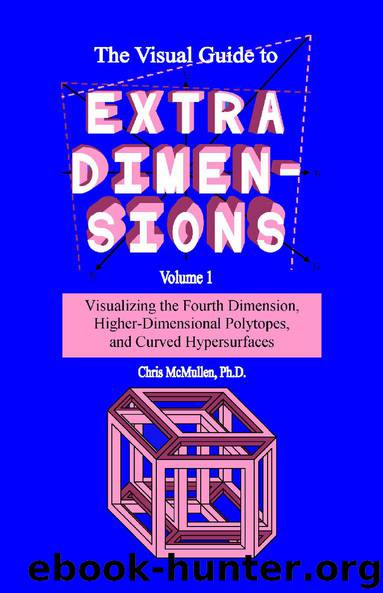The Visual Guide to Extra Dimensions: Visualizing The Fourth Dimension, Higher-Dimensional Polytopes, And Curved Hypersurfaces by McMullen Chris

Author:McMullen, Chris [Desconhecido]
Language: eng
Format: epub, azw3
Publisher: Amazon Publishing
Published: 2014-11-03T02:00:00+00:00
In the notation xn, which reads x raised to the power of n, n is called an exponent. Mathematically, xn means to multiply n x ’s together. For example, 34 =3·3·3·3 = 81. If n = 2, x is said to be squared; and if n = 3, x is said to be cubed. It is easy to see that xmxn = xm+n. This works for negative exponents, provided that x–n = 1/xn. Since xmx–m = x0 must be 1, any number raised to the zero power is unity: x0 = 1.
An N -dimensional cube has N sets of 2N–1 parallel edges – i.e. N(2N–1) edges all together. A point has no edges in accordance with 0(2–1) = 0, a line segment is its own edge as 1(20) = 1, a square has 2(21) = 4 edges, a cube has 3(22) = 12 edges, a tesseract has 4(23) = 32 edges, a 5D hypercube has 5(24) = 80 edges, and so on. Another way to put it is: A square has 2 pairs of parallel edges, a cube has 3 sets of 4 parallel edges, a tesseract has 4 sets of 8 parallel edges, a 5D hypercube has 5 sets of 16 parallel edges, etc.
Download
The Visual Guide to Extra Dimensions: Visualizing The Fourth Dimension, Higher-Dimensional Polytopes, And Curved Hypersurfaces by McMullen Chris.azw3
This site does not store any files on its server. We only index and link to content provided by other sites. Please contact the content providers to delete copyright contents if any and email us, we'll remove relevant links or contents immediately.
| Algebraic Geometry | Analytic Geometry |
| Differential Geometry | Non-Euclidean Geometries |
| Topology |
Modelling of Convective Heat and Mass Transfer in Rotating Flows by Igor V. Shevchuk(6347)
Weapons of Math Destruction by Cathy O'Neil(6073)
Factfulness: Ten Reasons We're Wrong About the World – and Why Things Are Better Than You Think by Hans Rosling(4616)
Descartes' Error by Antonio Damasio(3183)
A Mind For Numbers: How to Excel at Math and Science (Even If You Flunked Algebra) by Barbara Oakley(3175)
Factfulness_Ten Reasons We're Wrong About the World_and Why Things Are Better Than You Think by Hans Rosling(3156)
TCP IP by Todd Lammle(3091)
Applied Predictive Modeling by Max Kuhn & Kjell Johnson(2972)
Fooled by Randomness: The Hidden Role of Chance in Life and in the Markets by Nassim Nicholas Taleb(2961)
The Tyranny of Metrics by Jerry Z. Muller(2948)
The Book of Numbers by Peter Bentley(2867)
The Great Unknown by Marcus du Sautoy(2608)
Once Upon an Algorithm by Martin Erwig(2535)
Easy Algebra Step-by-Step by Sandra Luna McCune(2533)
Lady Luck by Kristen Ashley(2492)
Practical Guide To Principal Component Methods in R (Multivariate Analysis Book 2) by Alboukadel Kassambara(2443)
Police Exams Prep 2018-2019 by Kaplan Test Prep(2437)
All Things Reconsidered by Bill Thompson III(2322)
Linear Time-Invariant Systems, Behaviors and Modules by Ulrich Oberst & Martin Scheicher & Ingrid Scheicher(2300)
